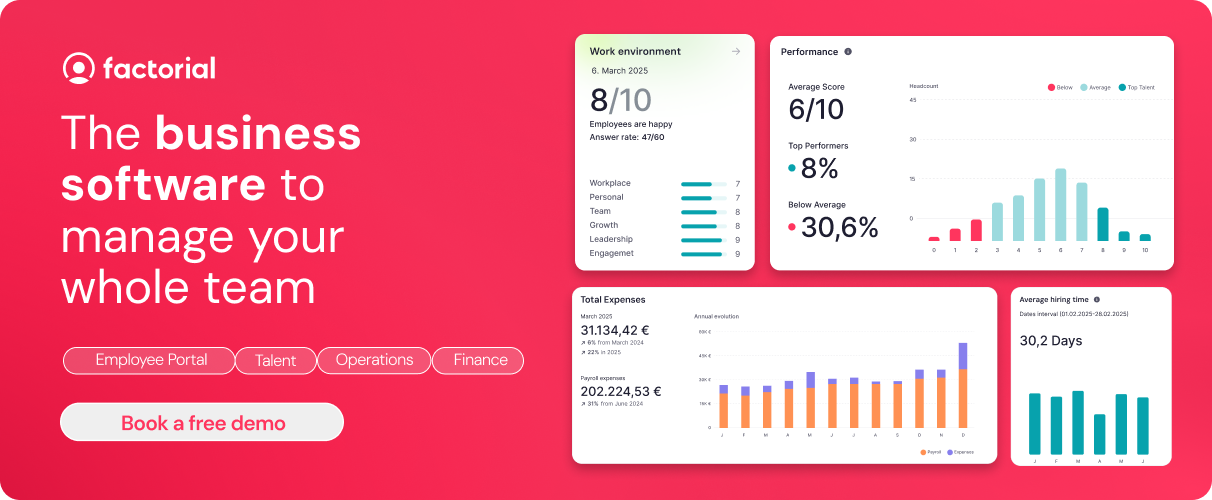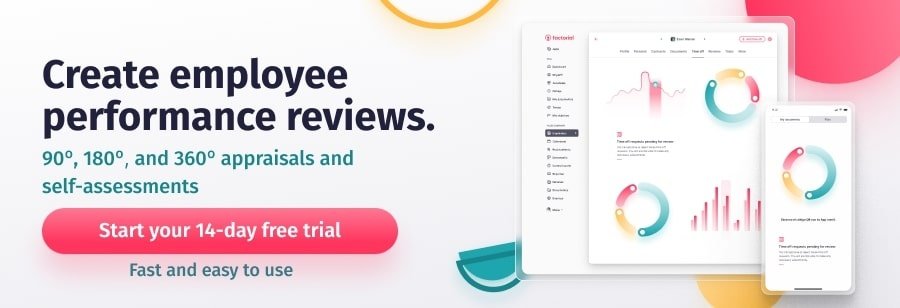Performance reviews are an integral function of the HR department. They help you gain insight, and they provide employees with valuable feedback that can help them reach their performance objectives. However, employee performance management is not without its challenges. One of these challenges is knowing how to detect and address bias in performance reviews.
A certain degree of bias is to be expected. We are human, after all, and our decisions are usually based on beliefs and intuition, not facts or logic. For instance, a study conducted by Harvard Business Review revealed that there is often a degree of gender bias in most performance reviews.
This makes it all the more important to be aware of our biases.
- Performance Appraisal Definition
- What is a Biased Performance Appraisal?
- Types of Bias in Performance Reviews
- How to Reduce Bias in Performance Reviews
- Create Unbiased Performance Reviews with Factorial ✅
Performance Appraisal Definition
In order to get the most from your continuous performance management strategy, you should be conducting regular employee performance reviews. A performance review benefits employees and employers alike. Even if your staff work from home, you should be conducting a regular performance review for remote workers. This should be in addition to your regular salary review process or any employee performance self-appraisals.
These reviews help you gather valuable data. You can use feedback to monitor progress towards goals and design performance improvement plans. If you use tools like 9-box or stack ranking, then reviews can help you establish where each employee should rank. Plus, employees have an opportunity to request performance coaching when necessary, which helps you build a high-performance culture. The feedback you get is also valuable for identifying who is eligible for rewards through any employee recognition programs you might have, such as pay for performance.
The Business Management Software your growing company needs.👇

What is a Biased Performance Appraisal?
The downside to these performance reviews is that they can never be 100% objective. You might encounter self-appraisal bias, racial bias in performance reviews, or errors and biases in performance appraisal for other reasons, as we will see shortly. These biases could be down to pre-existing prejudices and stereotypes, or unconscious biases. There is always a risk of bias in performance reviews because we are subjective humans.
Conscious or unconscious bias in performance reviews can obviously have a detrimental effect on your business. A biased review can falsely inflate or deflate your performance metrics, giving you a false reading of the performance levels of your company. A biased performance appraisal also makes it harder to judge how well an employee is actually doing: This can result in employee frustration and demotivation if an individual feels they have been held back unfairly from a promotion.
Types of Bias in Performance Reviews
Although bias in evaluation is difficult to avoid completely, being aware of performance management bias can go a long way to help you create a more inclusive performance management system.
The first step is knowing what to look out for. Then once you identify a biased performance appraisal, you can implement strategies to address potential issues.
Let’s take a look at some of the most common forms of bias in performance reviews.
1. Rater Bias in Performance Reviews
Rater bias, also known as rating bias, is when you allow your pre-existing biases to affect your evaluation of an employee, resulting in a biased performance appraisal.
A rater performance bias example might be when a manager evaluates skills they’re not good at highly. Or they might rate employees lower for skills that they have mastered themselves. This can have a hugely detrimental impact on performance data as scores end up being more of a reflection of the manager conducting the review, rather than the employee being reviewed.
2. Primacy Bias in Performance Reviews
Primary bias is when you let your first impression of an employee affect your overall assessment of them. For example, if an employee is transferred to your team and their manager warns you that they have had issues with performance, then you might judge them unfairly as a result of this first impression.
3. Leniency Bias in Performance Reviews
The next form of bias performance appraisal is leniency bias. This is when you give an employee an inflated rating because you feel a degree of sympathy or empathy towards them. For example, if you know an employee is having personal problems, you might be more inclined to give them a favorable review, even if they actually have notable room for improvement.
4. Halo / Horns Effect
The halo effect in performance appraisal is when you evaluate an employee favorably based on one thing that they do right, ignoring any other aspects of their performance. For example, you might have a salesperson who always hits their sales targets, so you judge them as a high-performer, ignoring the fact that they never submit their reports on time.
The horns effect, as you may have guessed, is the opposite effect. This is where you judge an employee unfavorably as a result of one thing they do badly. For example, an employee might always arrive late for meetings. As a result of this, you might rate them as being an underperformer, ignoring the fact that they always hit their performance targets and meet all deadlines.
5. Recency Bias in Performance Reviews
Another common bias in performance reviews is the recency bias. This is where you focus on what an employee has done recently, rather than looking at how they have worked during the entire performance cycle.
For example, one of your employees might have closed a big sales contract at the start of the performance cycle. More recently, they have missed a few potential deals. Recency bias is when you disregard the employee’s achievements at the start of the review period and focus exclusively on their underperformance over the past few weeks.
6. Central Tendency Bias in Performance Reviews
A biased performance appraisal can also result from the central tendency bias. This occurs when you give everyone on your team an average rating, regardless of individual performance. This might happen because you are overworked or because you find it difficult to be critical.
7. Similar-to-Me Bias in Performance Reviews
This form of bias in performance reviews is when you give a higher rating to individuals with similar interests, skills, and backgrounds as you. This one can be difficult to avoid as we tend to like and favor those that are like us. However, this can have a detrimental impact on your culture as it can make your workplace feel less inclusive for those who don’t share the same skills or interests.
8. Contrast Effect
This occurs when you evaluate an employee by comparing them to the last person who you wrote a review for, instead of against established performance standards. This might result in a positive or negative effect, depending on the person you are comparing them with.
9. Affinity Bias in Performance Reviews
An affinity bias is very similar to the “similar-to-me” bias. It occurs when we favor someone because we share similar affinities. For example, men might rate men higher than women, or older employees might rate their contemporaries more favorably. The same goes for gender, race, attitudes, educational background, or experiences.
10. Attribution Bias in Performance Reviews
This is one of the most common forms of bias. It is where you interpret the performance of others based on internal beliefs and opinions, rather than external logic and fact.
When it comes to judging ourselves, we like to think of our achievements as being the result of hard work, and our failures as being the result of external factors. But with attribution bias, we don’t apply this same to logic to others.
For example, if one of your team leaders is underperforming, you might judge them as underperforming because they lack the right skills, rather than being a result of a lack of support or resources. Constructive feedback needs to take into account all factors that might affect performance, both internal (skills) and external (resources).
How to Reduce Bias in Performance Reviews
As humans, we are naturally prone to relying on pre-existing biases, stereotypes and prejudices when we need to make assessments. We are also not very good at recognizing our own bias in performance appraisal. We shouldn’t let this put us off though.
Performance reviews can be a great opportunity for your managers to reflect on their own performance whilst conducting reviews. Encourage them to be more mindful and conscious of their own assumptions, stereotypes and cognitive biases. This will help your performance appraisals become less subjective so that feedback is more fact-based and constructive.
Another great way to reduce bias in evaluation is to use as many employee performance metrics as possible. You also need to make sure you set clear performance goals so that progress is easy to measure. Use tools like Factorial’s 360 Performance Assessment and 9 box grid to help you keep track of progress. And make sure each step of your performance management cycle is clearly documented. This will help your managers obtain a clear and objective picture of an employee’s overall performance.
Finally, the best way to reduce bias in performance reviews is to focus on creating a culture of trust. Encourage your managers to develop better relationships with their teams and promote an environment of positive performance management and diversity. Reward your top performers and offer training and support to any underperformers. This will help you create a culture where employees experience fairness and equity throughout the entire performance management cycle.


